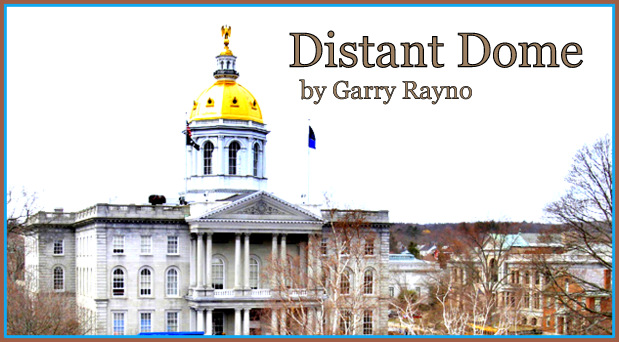
By GARRY RAYNO, Distant Dome
The state’s Annual Comprehensive Financial Report for fiscal year 2023 was released last week showing the state had continued its three-year run of good times since the COVID pandemic hit the state.
While Gov Chris Sununu touted a surplus of $527.2 million surplus, it was a revenue surplus exceeding estimates in the two-year budget that ended June 30, 2023.
The general fund surplus was $132.1 million when expenses are applied and that was transferred into the state’s Rainy Day Fund which now holds a record $291.5 million.
The Education Trust Fund had a $161 million surplus at the end of the last fiscal year and that money stays there to be used to pay education expenses including $24.5 million for the new Education Freedom Account program over the last two fiscal years.
General and education trust fund revenues totaled $3.22 billion for the last fiscal year, while budget writers had estimated it would be $2.69 billion, hence the half a billion dollar revenue surplus.
But while revenues did go up last fiscal year, they increased 2.1 percent over the year before, not as much as the two prior years when there was 8 percent growth for 2022 fiscal year revenues and 21 percent growth for 2021 revenues, which was extremely high due to the low revenue collection during the height of the pandemic.
The revenue surplus for the 2023 fiscal year was largely due to greater than anticipated returns on business taxes, $301.1 million, rooms and meals, $75.1 million and lottery at $50 million with several large jackpots in national games up for grabs.
While revenues have grown the last three years, so have expenses.
The budget approved in the 2022 and 2023 biennial budget for fiscal year 2023 was $2.79 billion, but the actual budget spending was $3.51 billion increased by some legislative actions, and also with budget writers for the current budget approved several hundred million in appropriations charged to the 23 budget.
But the $3.51 billion in spending exceeds the $3.22 in revenues and budget writers used surplus from last year’s budget to cover the shortfall.
In other words, revenue growth is slowing but the growth in spending is not.
The change in appropriations from the 2022 to 2023 fiscal years was $911.1 million, or a 10.8 percent increase, while all state revenues from 2022 to 2023 fiscal years grew by $588.8 million or 6.1 percent.
Last year’s budget’s bottom line was also helped by larger than anticipated lapses, which is money appropriated but not spent by departments.
The original budget anticipated lapses of $89.5 million, but was revised upward to $160 million, and actually produced $227 million in savings for appropriations that were not spent by various agencies, much of the lapsed money came from the Health and Human Services Department, which has consumed 47 percent of the state budget.
Education is the second biggest expense at a distant 20.3 percent, followed by general government at 11.5 percent, justice and public protection 9.3 percent, transportation 7.3 percent, and resources and environmental protection at 4.3 percent.
The past year’s budget was also helped by the influx of billions of federal dollars with direct and indirect impacts including nearly $2 billion in COVID relief and recovery funding and the American Recovery Program Act.
While the money had some specific purposes, it also allowed the state to use it for lost revenues and additional operating expenses due to the pandemic as direct impacts on the state’s financial picture.
The hundreds of millions of dollars in “pass through” money to businesses, nonprofits and organizations provides indirect help for the state in higher business taxes for example and various other revenue producers.
According to the annual audit, $254.2 million in State Recovery Fund federal money is credited to the state general fund.
Emergency Rental Assistance from the federal money amounted to $96 million according to the audit, $27.4 million went to capital projects although that might be low.
Federal money is also matched by state money in a number of programs, especially in Health and Human Services.
For example the Medicaid program, which includes the traditional program, the expanded program to help the working poor under the Affordable Care Act, and the Children Health Insurance Program (CHIP).
The Medicaid program totaled $2.55 billion for fiscal year 23, with 124,009 in the traditional program and 59,628 in the expanded program.
When all of the programs are put together the number of participants as of October 2023 was 181,637, which was down by 62,727 from a year before when eligibility was lowered during the pandemic and participants did not need to re-qualify each year as they normally would do. This reduction is known as the unwind.
During the health emergency for the pandemic the state received an extra 6.2 percent of federal match money meaning the federal government paid 56 percent of the cost and the state 44 percent.
If you look at the total state budget including state, federal and other revenue sources such as the Highway Fund and Fish and Game Fund, state spending totaled $8.31 billion in 2023, compared to $7.822 billion in 2022 or an increase of $488 million, granted that includes hundreds of millions of dollars the 2024-2025 budget writers added to the 2023 budget moving numerous appropriations into the prior budget.
The figures for the total budget of appropriations versus revenues shows a budget deficit of $62.5 million for the last budget year before other adjustments are made to the picture.
The 2022 total budget ended with a $96.3 million surplus which is how the state ended with a surplus that went into the Rainy Day Fund.
As Sununu says in his transmittal letter “This financial success has enabled us to meet the needs of the state. This includes the appropriations of hundreds of millions of dollars for housing, relief from high heating bills, and property tax relief — once in a generation investment to allow families, businesses and the economy to continue thriving.”
You could quibble with the property tax relief and not acknowledging the state’s overwhelming housing crisis which if not addressed will upend the state’s economy along with the child care crisis.
But yes it is a once in a generation investment of federal funds in the state and the other 49 that has provided the unanticipated revenues streams that in some states have already begun to shrink significantly.
New Hampshire’s tax system often results in the state being late going into recessions, but also late coming out.
For the first half of the current fiscal year, revenues are continuing to be greater than estimates by $86.3 million.
While about two-thirds of the annual revenue is yet to be collected in the second half of the fiscal year, it does not appear the revenue surplus is going to approach the half a billion dollars of the 2023 year.
The good times may not be over, but they are not likely to be quite as good as they have been.
Garry Rayno may be reached at garry.rayno@yahoo.com. Distant Dome by veteran journalist Garry Rayno explores a broader perspective on the State House and state happenings for InDepthNH.org. Over his three-decade career, Rayno covered the NH State House for the New Hampshire Union Leader and Foster’s Daily Democrat. During his career, his coverage spanned the news spectrum, from local planning, school and select boards, to national issues such as electric industry deregulation and Presidential primaries. Rayno lives with his wife Carolyn in New London.






